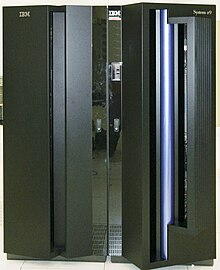
Back Mainframe AN حاسوب مركزي Arabic Meynfreym AZ Мейнфрейм компютър Bulgarian মেইনফ্রেম কম্পিউটার Bengali/Bangla Ordinador central Catalan Mainframe Czech Cyfrifiadur prif ffrâm CY Mainframe Danish Großrechner German



A mainframe computer, informally called a mainframe or big iron,[1] is a computer used primarily by large organizations for critical applications like bulk data processing for tasks such as censuses, industry and consumer statistics, enterprise resource planning, and large-scale transaction processing. A mainframe computer is large but not as large as a supercomputer and has more processing power than some other classes of computers, such as minicomputers, servers, workstations, and personal computers. Most large-scale computer-system architectures were established in the 1960s, but they continue to evolve. Mainframe computers are often used as servers.
The term mainframe was derived from the large cabinet, called a main frame,[2] that housed the central processing unit and main memory of early computers.[3][4] Later, the term mainframe was used to distinguish high-end commercial computers from less powerful machines.[5]
- ^ Vance, Ashlee (July 20, 2005). "IBM Preps Big Iron Fiesta". The Register. Retrieved October 2, 2020.
- ^ Edwin D. Reilly (2004). Concise Encyclopedia of Computer Science (illustrated ed.). John Wiley & Sons. p. 482. ISBN 978-0-470-09095-4. Extract of page 482
- ^ "mainframe, n". Oxford English Dictionary (on-line ed.). Archived from the original on August 7, 2021.
- ^ Ebbers, Mike; Kettner, John; O’Brien, Wayne; Ogden, Bill (March 2011). Introduction to the New Mainframe: z/OS Basics (PDF) (Third ed.). IBM. p. 11. Retrieved March 30, 2023.
- ^ Beach, Thomas E. (August 29, 2016). "Types of Computers". Computer Concepts and Terminology. Los Alamos: University of New Mexico. Archived from the original on August 3, 2020. Retrieved October 2, 2020.